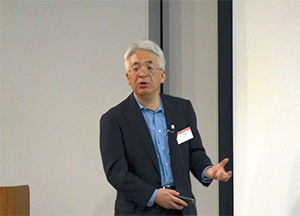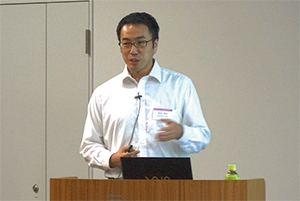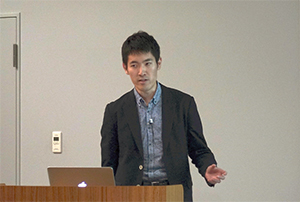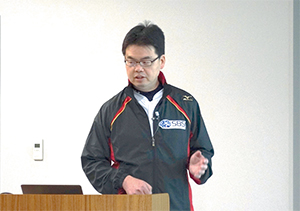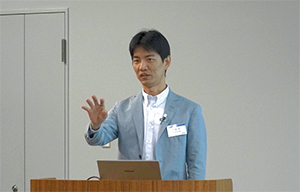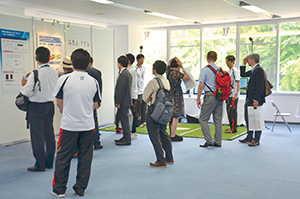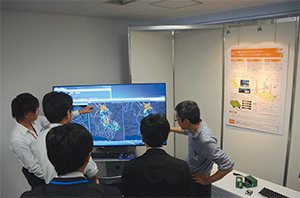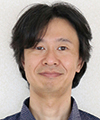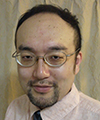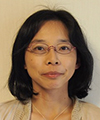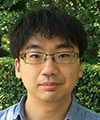 |
|||||
|
|
|||||
|
Information Vol. 15, No. 11, pp. 49–53, Nov. 2017. https://doi.org/10.53829/ntr201711in1 Event Report: NTT Communication Science Laboratories Open House 2017AbstractNTT Communication Science Laboratories Open House 2017 was held in Keihanna Science City, Kyoto, on June 1 and 2, 2017. Nearly 1800 visitors enjoyed 6 talks and 29 exhibits, which focused on our latest research activities and efforts in the fields of information and human sciences. Keywords: information science, human science, artificial intelligence 1. OverviewAt NTT Communication Science Laboratories (NTT CS Labs), we are engaged in two types of fundamental research. The first is research to benefit the future. We are leading the world in preparing for a new era by developing technologies that will bear fruit five to ten years from now and by accumulating knowledge. The second is research that addresses the needs of modern society. We are utilizing the technologies and knowledge we have cultivated to tackle societal challenges directly confronting us now. NTT CS Labs Open House has been held annually with the aim of introducing the results of the labs’ basic research and innovative leading-edge research to both NTT Group employees and visitors from companies, universities, and research institutions who are engaged in research, development, business, and education. This year, Open House was held at the NTT Keihanna Building in Kyoto on June 1 and 2, and nearly 1800 visitors attended it over the two days. We prepared many hands-on exhibits to allow visitors to intuitively understand our latest research results and to share a vision of the future where new products based on the research and development (R&D) results are widely used. We also organized an invited talk. This article summarizes the event’s research talks and exhibits. 2. Keynote speechOpen House started with a speech given by Dr. Eisaku Maeda, Vice President and head of NTT CS Labs (currently, Professor at Tokyo Denki University), entitled “Basic Research in the Age of AI×IoT×BigData—New Design of R&D Processes by the Blending of Science and Engineering,” (Photo 1).
Dr. Maeda pointed out that the convergence of three fundamental technologies—new data technology known collectively as artificial intelligence (AI), new data infrastructure called IoT (Internet of Things), and vast collections of data of unprecedented size and quality referred to as big data—is now having a major transformative impact on the world. He also pointed out that pure science and engineering have always been pursued as independent disciplines, but this is now undergoing a major change caused by developments in the above technologies. Through this change, feedback loops from science to engineering to implementation and back to science occur repeatedly, becoming ever thicker, and the sequence revolves at an ever faster rate. He stated that in these circumstances, even areas of scientific research that up to now have been conducted in idyllic independence must be strategically reexamined in terms of overall economic efficiency. 3. Research talksFour talks were given, as summarized below, which highlighted recent significant research results and high-profile research themes. Each presentation introduced some of the latest research results and provided some background and an overview of the research. All of the talks were very well received. (1) “Discovering hidden structure in big data—Knowledge discovery based on probabilistic latent variable models,” by Dr. Tomoharu Iwata, Ueda Research Laboratory Dr. Iwata explained a generative model approach that can automatically find intrinsic latent features from a huge amount of data, which can be easily obtained from the Internet and sensors. He provided guidelines for modeling data by introducing specific models for some applications, such as topic extraction and object matching (Photo 2).
(2) “Generative personal assistance with audio and visual examples—Deep learning opens the way to innovative media generation,” by Takuhiro Kaneko, Media Information Laboratory Mr. Kaneko introduced generative personal assistance with audio and visual examples, which can give feedback or instructions to a person who wishes to perform a task better or to do new things. He explained a new deep learning approach to overcome the limitations of existing methods based on manually defined rules and discussed future directions in this research field (Photo 3).
(3) “What is special about excellent batters?—The essence of fine skills in the light of implicit brain functions,” by Dr. Makio Kashino, Sports Brain Science Project Dr. Kashino focused on batting in baseball and explained the mechanisms of implicit brain functions, that is, information processing in the brain that the players themselves are not aware of. He presented the results of analyzing various biological data obtained from players and pointed out the key role of implicit brain functions (Photo 4).
(4) “Does breathing change the impression of a sound?—Interactive relationship between respiration and sound, and its effect on emotion,” by Dr. Takashi G. Sato, Moriya Research Laboratory Dr. Sato explained the experimental results indicating that breathing (inhalation, exhalation) makes a difference in how the body responds to presented sound. He also discussed the vision of human interfaces that modify their stimulus presentation according to the state of human activity (Photo 5).
4. Research exhibitsOpen House featured 29 exhibits displaying NTT CS Labs’ latest research results. We categorized them into four areas, “Science of Machine Learning,” “Science of Computation and Language,” “Science of Media Information,” and “Science of Human and Communication.” Each exhibit was housed in a booth and employed techniques such as slides on a large-screen monitor or hands-on demonstrations, with researchers explaining the latest results directly to visitors (Photos 6 and 7). The following list gives the titles of the research exhibits in each category. More details can be found on the website [1, 2].
4.1 Science of Machine Learning
4.2 Science of Computation and Language
4.3 Science of Media Information
4.4 Science of Human and Communication
5. Invited talkThis year’s event also featured an invited talk by Mr. Takamasa Sakai, R&D Director, Hakuhodo Institute of Life and Living (a think tank of the Japanese advertising firm Hakuhodo). The title of his talk was “Four scenarios of future city.” He described current social issues in Japan such as the aging of the population, unstable employment, and the increase in one-person households, obtained from the results of a public opinion survey on the future of cities. He also talked about living environments and human relationships in the future, taking into account the above issues and the survey results. He then derived four scenarios of future cities—a city without keys, a city without addresses, a city without walls, and a city without windows—and explained them from various perspectives, including a technology perspective, by examining the results of a public opinion survey on the four scenarios. 6. Concluding remarksJust like last year, many visitors came to NTT CS Labs’ Open House 2017 and engaged in lively discussions on the research talks and exhibits and provided many valuable opinions on the presented results. In closing, we would like to offer our sincere thanks to all of the visitors and participants who attended this event. References
|
|||||

